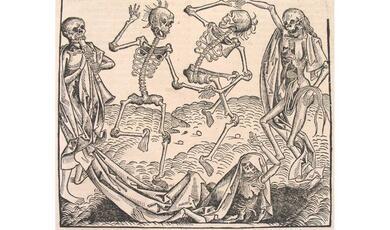How Genetic Adaptation Helped Humans Colonise the Globe
Share
- Details
- Text
- Audio
- Downloads
- Extra Reading
Modern humans evolved in Africa and successfully colonised the globe only in the last 100,000 years or so, a feat made possible by cultural and genetic adaptation. Human habitats differ dramatically in climate, available foods or pathogens, and genetic adaptation was mediated both by mutation and by interbreeding with archaic humans such as Neanderthals and Denisovans.
Besides representing a mark of our past, these adaptations contribute to diversity in living people in traits such as skin colour and immune function.
Download Text
How Genetic Adaptation Helped Humans Colonise The Globe
15th June 2022
My name is Aida Andrés and I am an Associate Professor at University College London. My work aims to help us understand how populations and species adapt to their environment, and how these past evolutionary events affect individuals today. When it comes to humans, genetic adaptation is a very interesting question for multiple reasons. It informs us about our own evolution, which is intrinsically interesting to us. But also, humans are a very unique animal. First, because we have a highly advanced cognitive function, culture, and a series of unique characteristics. How did we evolve these amazing traits? Second, because humans have managed to colonise, very quickly, virtually the whole globe. Being cosmopolitan (present all over the world) is not typical in the animal kingdom, it is not observed in other primates and even in other human forms, and it makes our species (modern humans) quite unusual. And I find it fascinating that while somehow our own evolution likely resulted in traits that allowed (or even compelled) us to migrate and colonise the globe, such migrations generated local adaptations that in turn shaped our own evolution. Third, because these past adaptations live today in our genomes, shaping how we are, look, metabolise food or fight pathogens, and sometimes our individual disease risk.
The focus of my talk today is how early humans have managed to adapt genetically to such variety of environments, touching a bit on the consequences of these adaptations for people living today.
Let’s start at the beginning, with how humans emerged as a species and colonized the word. Most people would probably correctly identify chimpanzees as our closest living relative. In fact humans are equally related to chimpanzees and bonobos—a lesser-known sister species with a much smaller population size but very interesting characteristics, for example a female-led society characterized by peaceful interactions and little violence, as opposed to chimpanzees (and arguably humans). We shared a common ancestor with chimpanzees and bonobos only 4-6My ago, which is a very short time in evolutionary terms, share most of our biology and physiology and also our genome: our genomes are 99% identical to those of chimpanzees and bonobos. In many branches of life, subspecies of the same species are more different to each other than we are to chimpanzees and bonobos.
Beyond chimpanzees and bonobos, we belong to the family of the great apes, which includes gorillas and orangutans. Sadly, we have made every subspecies of every other species of great apes endangered.
Other evolutionary cousins of modern humans are already extinct. There are of course no subspecies of humans, but other human forms inhabited earth and got extinct. Famous are Neanderthals, which lived in Eurasia for many thousands of years, leaving many remains. But there were many others, some that we know very little about. An example are Denisovans, a sister group of Neanderthals that we ignored that existed until a tiny bone of a pinkie was sequenced, revealing the existence of a completely unknown population of humans. And establishing the power of genetics to understand human evolution! These populations went extinct as humans thrived and increased in numbers but early modern humans met them and indeed interbred with them (they had babies together) so many of our genomes contain segments that are of Neanderthal or Denisovan origin (that once belonged to the genome of a Neanderthal or a Denisovans). This is a very interesting story but I will not go into details today.
Rather I’ll focus on more recent times and our preferred organism, modern humans. Modern humans evolved in Africa, this map suggests that in south Africa although we now believe that it may have been in East Africa. Only in the last 50-100 kya modern humans successfully colonized territories outside of Africa. This probably worked as small populations of humans migrating out of Africa, then increasingly towards new Eurasian territories and eventually colonizing the globe. This migration is termed the “Out-of-Africa migration” (OAM), and it had a dramatic influence in human evolution. For starters, it means that all humans have an African origin, ultimately. But it also had strong impact on the genetics of human populations. First, as a consequence of the OAM genetic and phenotypic diversity is much larger in Africa than outside of Africa. A second consequence of our demographic history is that humans are highly homogeneous, both genetically and phenotypically (in our traits), and both within and across populations. For example, nly 1/1000 genomic bases (letters) differ between the genomes of two individuals. Of those, 90% vary within populations (only 10% differ between populations). Even the 10% do not represent biological differences among “races”, which are a societal construct rather than a biological entity.
A third consequence of our demographic history is that most of human evolution happened in Africa, so even if early modern humans were well adapted to those environment, in a short evolutionary time they colonized new territories that differed drastically in terms of temperature, diet, pathogens, altitude, survival strategy, and other critical environmental conditions. So these migrating populations were subject to a phenomenal pressure to adapt locally. Cultural adaptations definitively facilitated life in those environments, but we know that early modern humans were under strong pressure to adapt biologically and, indeed, adapted in many cases.
How does a population adapt to a new environment, either because the population moves to a new habitat (as in the case of many early modern humans) or because the environment changes (as in the case of all species facing climate change?). And how do we learn about these adaptations?
Genetic adaptation happens through natural selection. The process described by Charles Darwin, where individuals that are better fit in an environment (typically because they are better at surviving or reproducing in that environment) have more offspring. If their offspring inherit these traits, because they are genetically encoded, they will have higher fitness and more offspring too. The frequency of the beneficial traits increases in the population every generation, and with it the average fitness of individuals in that population. So beneficial traits increase in frequency the population and mediate adaptation to the environment . Conversely traits that are deleterious disappear from the population because individuals that carry them have lower fitness –less offspring. There are other types of natural selection, but selection that mediates adaptation a new environment is positive selection.
Under neutral evolution the traits may vary a bit in frequency across generations, by chance (random genetic drift). But overall the frequency is relatively constant and the change is slow. Under positive selection the beneficial traits increase quickly in the population to reach high frequency very fast. Often all the individuals in the population acarr the beneficial trait and the ancestral trait disappears from the population. For traits that are at genetically encoded, of course genetic variants are responsible for the trait. So this represents exactly what happens in the genome. Individuals carrying a beneficial genetic variant have higher fitness, their offspring inherit the beneficial genetic variant, and the frequency of this genetic variant increases in the population over time.
Let’s stop for just one second to see how we can use this to identify past adaptations. We can sequence a sample of genomes and we can identify that one individual has a T where other individuals have a C in the genome. This is a position in the genome that is variable in the population: there are two forms (C,T) that are called alleles. We can easily calculate the frequency of the two alleles in the population (or our sample of the population), here two out of ten, 20%. Going across the genome we can identify all positions that are variable, and calculate their allele frequencies. And with this information we can start making inferences about the evolutionary history of these genetic variants. In real life we would use much more information than just allele frequencies, but for simplicity I will not talk about that today.
In humans, thousands of genomes are now publicly available so we can analyse the evolution of every letter of the genome in dozens of human populations. We also have genomes of ancient modern humans (modern humans that lived from a few hundreds to many thousands of years ago) that improve our inferences. And we even have the genomes of some Neanderthals and Denisovans – great insights into our past.
Let’s use a toy example. We have a genetic variant with two alleles, both green and orange alleles are neutral. There are minor changes in frequency in different populations just by chance (drift). But now let’s imagine that the allele is beneficial in a given population: it will be favoured by natural selection in these populations, increase its frequency, and with time it will likely reach high frequency in these populations –and only in this population. The population is genetically adapted to its local environment for this trait (locally adapted) due to the high frequency of the beneficial allele.
An easier way to represent allele frequency is in a pie chart. And if I came to you to tell that I am studying this genetic variant and showed you this map, given that we just discussed that human populations are highly homogeneous and allele frequencies change slowly under neutral evolution but quickly under local adaptation, you would identify this as an unusual pattern and this as a very interesting genetic variant.
We just used the fact that a genetic variant shows striking (uncommon, unexpected) differences in allele frequency across populations as a hint that the evolution of this variant is probably shaped by local adaptation. That “hint” is what we call a signature of natural positive selection. A signature is a footprint of the action of past selection that we can observe in genomes today. They work extremely well to identify genetic variants that likely mediated local adaptation during human evolution. There are many signatures of selection besides allele frequency change, although for simplicity I will continue focusing on this signature today.
Now that we understand well how local adaptation works, and how to identify it in genomes, let’s move to these interesting questions.
Adaptation to milk in the diet is arguably the most famous example of local genetic adaptation in humans. In most species of mammals, adults are unable to digest milk. Many adult humans are able to digest milk, due to the continued expression of Lactase into adulthood. The lactase gene has some of the strongest signatures of local adaptation in the human genome. The alleles that retain expression of Lactase into adulthood have appeared in European and Africa pastoralists, and have strong signatures of positive selection in both. Milk has provided a source of nutrition and clean to individuals that consume it. Note that this is bio-cultural co-adaptation.
Another prime example of local adaptation is adaptation to solar exposure. There are striking differences in solar exposure around the world. When solar exposure is high, we need protection of the skin through pigmentation. When exposure is low, we need to retain exposure to generate vitamin D, which requires the sun. The high diversity of solar exposure around the globe has thus resulted in a wonderful, amazing diversity of pigmentation levels across the globe. While we believe that there was strong pressure to increase pigmentation as humans moved from deep forest into savannah habitats and lost body hair, more recently there was probably strong local adaptation to reduce skin pigmentation at high latitudes –with signatures of selection across a battery of genes.
There are also well-established adaptations to pathogens, height and other. Understanding these evolutionary processes helps understand the origins of individual and population differences, and when these relate to health it helps us understand the origin of important health inequalities across human group.
I will now focus on a less-well-known and understood case of potential local adaptation: ambient temperature. This is very important for a number of reasons. First, it affects many populations in a gradient way, as temperature varies gradually across the world. Second, it helps us understand how populations and pecies can adapt to changes in ambient temperature, which is critical in the face of and climate change.
How do we perceive cold? The discovery of the molecular basis of temperature and touch sensation merited the the Nobel prize for physiology or medicine last year (2021, David Julius and Ardem Patapoutian). It is an extremely important system that regulates how we interact with our environment. We feel temperature through nerves that innervate the skin. These nerves have proteins (ion channels) that allow ions to travel across the cell membrane and whose activity changes with temperature, sending signals to the brain about ambient temperature. There is a family of these receptors, and interestingly they are also activated by substances. For example TRMP8, the cold receptor, is activated by mint –and is responsible for the fresh sensation that we feel when using mint-based products such as toothpaste or gum (this is TRMP8 in the nerves that innervate your mouth activating with menthol and telling your brain that it’s cold here).
TRPM8 is the best established cold receptor, being active at cold temperatures. TRMP8 seems to have mediated adaptation to cold ambient temperature in some species. For example, when researchers compared its activity across species, they observed that the channel is less active in species that live in very cold climates (penguins) than species that live in warm climates (elephants), perhaps because species have reduced its activity to be able to continue normal life even when it is in very cold. Likewise, rodent species that hibernate also have a form of TRPM8 that is less active than species that do not hibernate, perhaps for similar reasons.
So the obvious question is, has TRPM8 also contributed to local adaptation in humans?
We studied a genetic variant that we believe is functional in TRPM8. There are very large allele frequency differences among populations. Actually, only 0.02% of all variants in the genome have larger allele frequency differences between Finish and Yoruba than this one. The gene also has multiple additional signatures of positive selection. And interestingly, the allele frequency of this allele correlates significantly with latitude. This is unexpected and very unusual in the genome.
We thus believe that TRPM8 likely contributed to adaptation to increasingly cold environments as humans migrated to higher and higher latitudes, likely generated the frequency gradient that we observe today. It is interesting that the allele that has high frequency in high-latitude populations seems to increase cold sensitivity, perhaps to increase our ability to respond to temperature drops with physiological and/or behavioural changes. But also, this allele increases the risk of migraine. So we believe that the genetic adaptation in the TRPM8 cold receptor likely increased cold sensitivity and, as a side effect, also increased the risk of migraine in some human groups.
This is thus perhaps an example where adaptation to an environmental factor may have increased the frequency of an allele that results, today, in increased risk of disease in certain human populations.
An interesting additional approach to studying adaptation to cold habitats is studying populations living in extremely cold environments, such as the Greenland Inuits. Do they show similar or additional adaptations to those we observe among human populations living in non-extreme cold habitats? A group of my colleagues studied local adaptation in the Inuit and actually identified that the strongest evidence of local adaptation was in FADS genes. These genes encode the rate-limiting enzymes in the synthesis of long- chain polyunsaturated fatty acids (PUFAs), including omega-3 fatty acids. The traditional diet of the Inuit is based on fish and marine mammals and rich in long-chain omega-3. The Inuit seem to have adapted to decrease the rate of endogenous synthesis of these molecules (as they are acquired through the diet) and instead increase the synthesis of short chain PUFAs, which are ordinarily obtained from a vegetarian diet. These genetic changes have strong effects including potentially protective of cardiometabolic traits in people with such a fat-rich diet.
Adaptations to extreme environments are an extremely interesting avenue of research, as they have allowed humans to adapt to even the most inhospitable of habitats in terms of temperature, altitude, activity or pathogens.
To conclude, human populations are highly homogeneous, both in our genes and our traits. Yet, as early modern humans migrated around the world local positive selection allowed then to adapt to their local environments. These processes resulted in key adaptations to different climates, diets or pathogens, among other selective forces. In addition, specialised genetic adaptations have allowed humans to colonise extreme habitats. These evolutionary events live today as differences among individuals and populations in important traits, including susceptibility to disease. The study of genomes using evolutionary population genetics is thus a critical tool to better understand not only human evolution, but also the important effects that our evolutionary history has in people living today.
© Professor Andres, 2022
This event was on Wed, 15 Jun 2022
Support Gresham
Gresham College has offered an outstanding education to the public free of charge for over 400 years. Today, Gresham College plays an important role in fostering a love of learning and a greater understanding of ourselves and the world around us. Your donation will help to widen our reach and to broaden our audience, allowing more people to benefit from a high-quality education from some of the brightest minds.


 Login
Login







